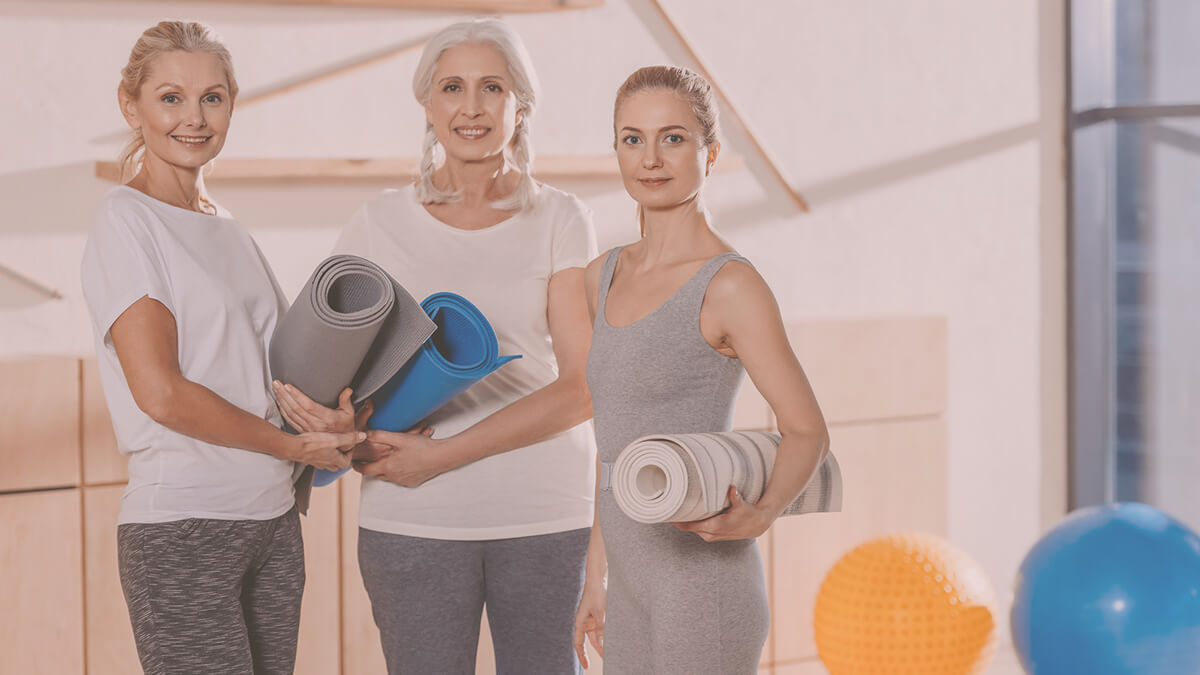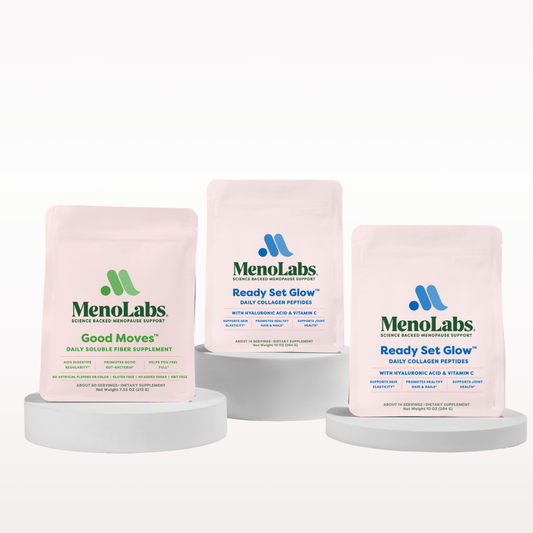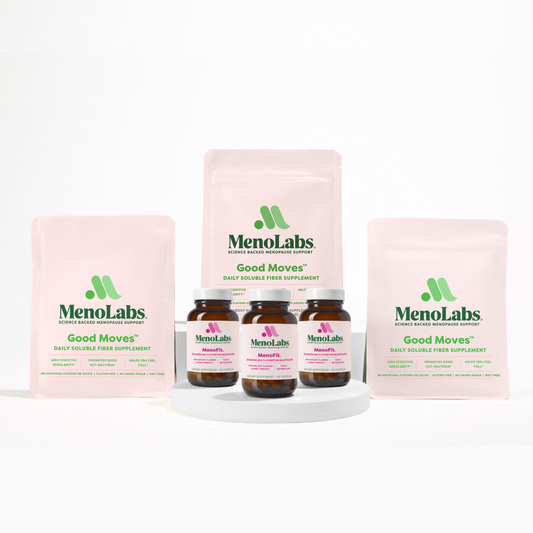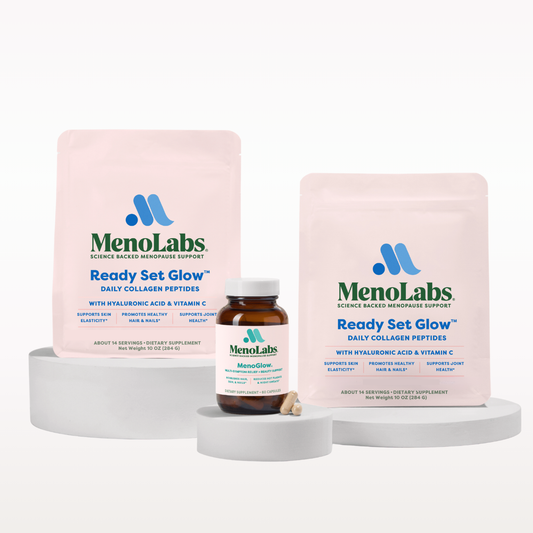
- movement
Why Light Exercise Can Help Your Bones
Bone loss in menopausal women is relatively common. Postmenopausal osteoporosis is one of the most widely reported illnesses that women suffer from toward the end of their lives.
1 min read
Bone loss in menopausal women is one of the most common ailments in the world, with 1/3 of people age 50-60 experiencing it — a number that rises to 1/2 among people 80 and over.
In perimenopause, estrogen levels start to drop. Though estrogen is primarily known to help regulate the female sexual reproductive system, it also helps to maintain bone health. So as estrogen drops, so does bone density — which leads to a higher risk of bone fractures, and of difficulty recovering from them.
While there are a multitude of ways to help combat this issue, light to moderate strength training exercises are proven to help reduce the risk of fracturing bones. The muscle tissue that surrounds bones acts as a protective layer of padding between the skeletal system and the environment. It also strengthens areas of the body that are more susceptible to injury, primarily the joints.
Not every kind of exercise helps with bone density. The best kinds of exercises for this issue are weight-bearing and resistance exercises. Both of these activities help strengthen muscles and prevent bone density from further deteriorating.
Weight-Bearing Exercises
Weight-bearing exercises are lower and upper body exercises in which the body works against the force of gravity, carrying a person's full body weight. Integrating some weight-bearing exercises into your workout routine can slow the loss of bone density.
1) Push-ups
Push-ups can be difficult even when we're young. However, there are ways push-ups can be incorporated into a daily routine without over-exerting yourself. Wall push-ups are a great form of this exercise, as they help build muscles in the shoulders, without being as difficult as traditional push-ups. As the arms compress, the weight of the upper body is placed on the bones in the arms and chest. As the body pushes away from the wall, the muscles in the arms pull on the bones, making them stronger.
2) Lunges
Lunges help to strengthen the lower body, particularly joints like the knees and ankles. Forward lunges help strengthen the knees and calves by placing all body weight on the front leg before stepping back. As a result, the muscle tissue surrounding the knee forms a protective layer around the knee socket. Lunges are a great exercise to help stabilize the lower body and prevent bone loss in the knee joints.
3) Squats
Squats aid in strengthening the hips and the core — two areas that menopausal women often find have weakened, which can cause pain in the midsection and back. Squats help relieve some of these symptoms by placing pressure on the hip joints to help strengthen existing bone density.
4) Yoga
Yoga is known to help promote flexibility, relieve stress, and improve muscle tension. However, it has some positive effects on bone health, as well. Holding yoga poses can help stretch muscle tissue and fortify joints in the upper and lower body.
5) Pilates
Similar to yoga, pilates provides several benefits to the body, including prevention of bone loss, and increased cardiovascular health. Leg lifts are ideal for targeting and strengthening hips, while dynamic alignments help improve the upper body and strengthen the core.
Resistance Exercises
Resistance exercises are exercises that force skeletal muscles to contract. These activities use the push and pull of motion to help place full body-weight on most of the bones in the body, which increases muscle mass, bone strength, and endurance.
1) Side Raise
Side raises are excellent for the upper body and back. Placing both feet on a resistance band, take both ends of the band in the hands. Slowly outstretch the arms until they are completely perpendicular to the body, then lower them until they rest against the body naturally.
2) Shoulder Press
Apart from the knee joints, shoulder joints are the most sensitive areas on the body. Without muscle, the likelihood of these joints dislocating or fracturing increases, especially during menopausal bone loss. Shoulder presses are a resistance exercise that can help build muscles around the shoulder joints and prevent them from being damaged. Stepping on a resistance band and raising the arms over the head, muscles along the shoulders pull on the joints.
3) Chest Press
Chest presses may work most of the upper body, but they can also help provide a full-body workout, depending on the position and the degree of stretch. Place one foot behind the body and step on the resistance band. Then, taking the ends of the band in each hand, stretch the arms outward toward the opposite wall. With the arms still raised, bring them back into the chest, similar to a push-up.
4) Side Leg Raise
Side leg raises can be a fundamental tool in helping increase bone strength throughout the hips and legs. Wrap a resistance band around the legs just above the ankles. Stand with both feet a few inches apart. Then raise one of the legs outward and to the side. Raise the leg until the resistance band is taut. Then lower the leg back down until both feet meet.
5) Bicep Curl
The upper body muscles are the most difficult to maintain as we go through menopause. Muscle tension in the body becomes slack and loses its elasticity as estrogen depletes. As a result, upper body strength and bone health suffer. Bicep curls can help prevent that, by helping maintain muscle tissue in the upper arms.
Stand on the resistance band shoulder-width apart. Then, taking both ends of the band in each hand, curl the arms upward at the elbows. Bring the forearms up to the chest before lowering them down to rest at the sides.
Related Products
Blend Besties Bundle
Fresh Start Bundle
4.7 / 5.0
(554) 554 total reviews











